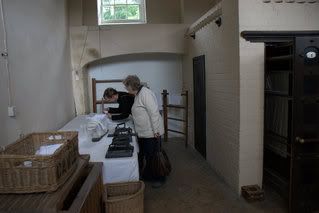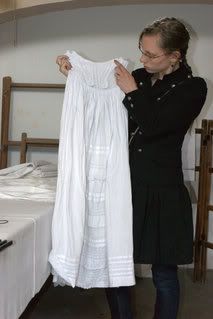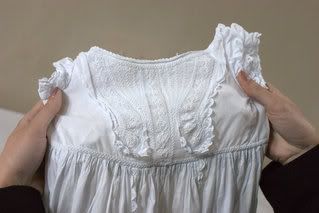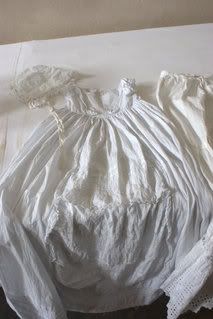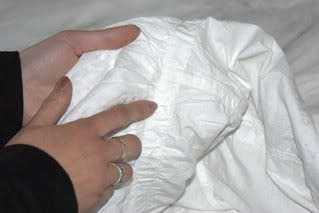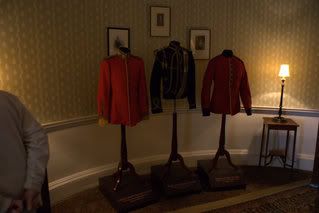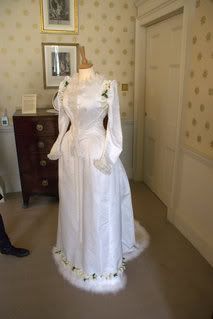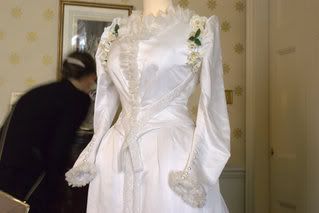Saturday, 19 June 2010
Some unexpected gems discovered.
While I was on holiday I didn't go out on the hunt for costume specifically, but I always keep an eye out and it's awlays nice to stumble across some delicious examples to add to my research library.
My first discovery was tucked away in a cupboard of all places in the delightful National Trust property of Townend. Out of the light, but such a shame! I wasn't able to get any photos sadly, but sheltered in the dark was an 1830s wedding gown in delightful sprigged silk. Although undoubtedly faded, the silk was still crisp and would likely have been a rich cream or even a primrose yellow (a popular colour of the period). The gown itself was simple in style with a waistband about an inch wide at the fashionable height between underbust and natural waist. Full leg o' mutton sleeves taper down to tight cuffs and the skirt falls in folds from the gathered waistline. The most interesting and distinguishing feature of the gown was the capelet style collar. Two tiers which tapered down to rounded points extended to the waistline, edged in piping. Although indistinguishable, I suspect the capelet extends into a single rounded point at the centre back.
Tuesday 22nd June 2010
Berrington Hall
We joined the National Trust to give us value for money days out in some beautiful places and I could enjoy many secret 'Elizabeth Bennett moments' as I toured the grand parks and elegant state rooms of the British aristocracy. Perhaps, rather naievly, I wasn't expecting them to have such an extensive collection of costumes in their care, but what's most delicious is that they aren't all kept in one location which enables you to make exciting discoveries as you visit different places.
Our visit to Berrington Hall was completely unplanned. It had been our intention to visit somewhere else, but upon arrival discovered the place closed, so a quick perusal through the National Trust handbook lead us just a few miles to nearby Berrington.
First on our tour we discovered the wonderful Edwardian laundry which makes every woman grateful for the invention of the modern washing machine and electric steam iron. In the photo below you can see the huge drying cupboards to the left while I show my mum the little treasures that had been left out on the ironing table.
On the table was a beautiful white cotton infant's gown full of all the gorgeous little details you'd expect....
Here are some more pictures to show you all the delicate little details of the pintucking, insertion lace and emboidery...
The gathering of the skirt to the waistband is very delicately done and the little gathered sleeves are made by mounting the puffed section onto a cap sleeve lining.
In this photo you can see the adorable little baby cap which is equally adorned with lace and embroidery. Although it's enough to make most women broody, the reason I was so delighted with this find is that it demonstrates how highly trimmed cotton garments were. Everything from blouses to bloomers would have had some form of decorative detail and garments that were designed to be 'seen' like this baby gown, were highly adorned. There's applied lace ruffles and insertion lace (which would have been ready bought), there's hand embroidery on the bodice and all the way around the waist and then there's the tiny little pintucks on the front of the skirt - all pefectly even and level!
Also on the ironing table was a corded and pintucked petticoat which also had channels on the inside for hoops to be inserted.
Inside the main house there were also more delicious sights to behold.
There was a collection of military jackets belonging to the family's three sons, all of whom tragically died in the First World War.
In one of the other bedrooms was a recreation of 1890s wedding gown. Although not 100% authentic in it's replication the construction and shape of the actual garment was worth recording. It was recreated from one of the family photographs, but sadly the marriage didn't end happily.
Originally the gown would have been trimmed with maribou feathers and the orange blossom pinned on would have been fresh as per the Victorian tradition. The gown was very plain apart from the trimming and the v-shaped gathering detail on the front bodice.
The skirt is pleated onto the waist band creating a columnular style at the front while the back is tightly gathered under the bodice to create sweeping folds that form an elegant train. The picture isn't terribly clear but you can see the gathers and the fantastic hourglass shape of the waist and hips at this period.


